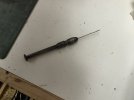Ralphmp
Registered
I need to drill a small hole (about 1mm) in a white metal casting. Any advice on what type of drill bit, drill speed, etc. would be welcome.
Also, I’d like to paint the casting black when I’ve put the hole in it. Again, any advice on surface prep and type(s) of paint would be appreciated.
Thanks
Also, I’d like to paint the casting black when I’ve put the hole in it. Again, any advice on surface prep and type(s) of paint would be appreciated.
Thanks

